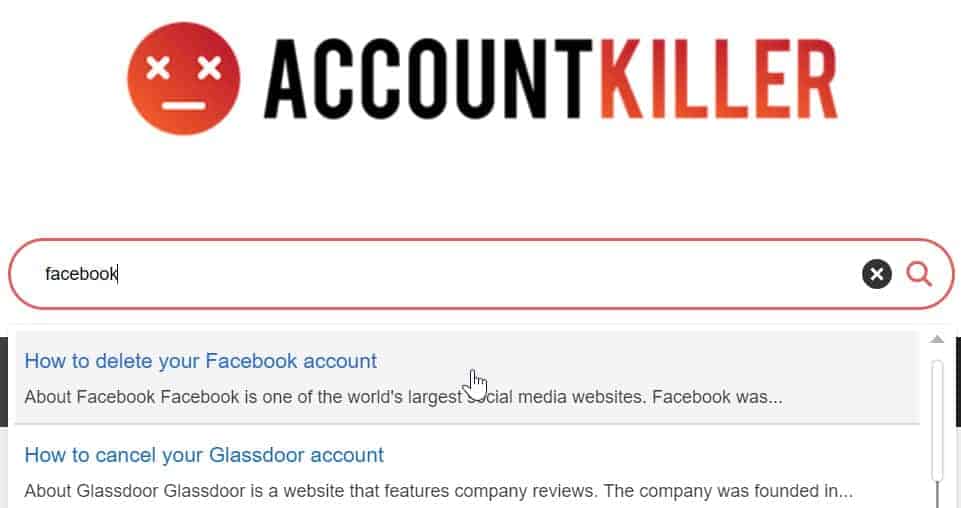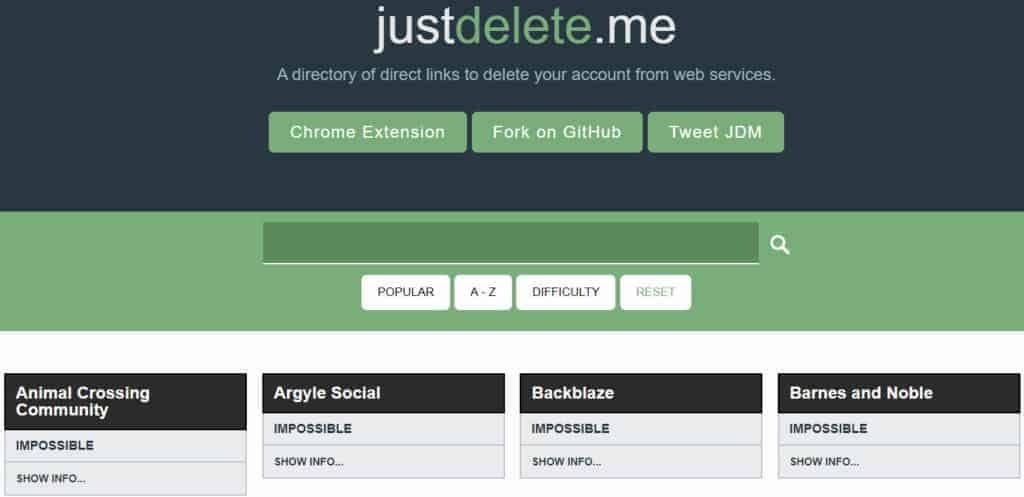In today’s woke internet culture, if someone tells you to “delete your account”, it’s usually not because they’re concerned for your online privacy. Nevertheless, you may want to delete online accounts that you haven’t used in a while. Old accounts are susceptible to hackers. Any information you’ve left sitting around could leave you vulnerable to identity theft, financial loss, and additional account takeovers.
But, as anyone who’s ever tried to delete an online account can attest to, it’s not always as simple as logging into the website and clicking “delete account” in the privacy settings. Many sites now hide their account deletion methods within a labyrinth of web page links. Others won’t let you delete your account without imposing archaic rigamarole, like sending a support email.
This being the case, you may need to use a tool to delete online accounts or find a service that can help you navigate a website’s account termination process.
Best account deletion websites
Not many websites occupy this space, but the two best sites to help you delete online accounts include:
- AccountKiller: Provides step-by-step information on how to delete over 1,500 online accounts.
- JustDelete.me: Over 500 account deletion guides, color-coded green, yellow, and red for the difficulty in deleting accounts.
AccountKiller
Based on size alone, AccountKiller is, well, a killer service for account deletion information. Much of the information on this site is user-submitted, so it may not always be as accurate as possible. However, with over 1,500 sites and services listed in its database, it’s undeniably the largest of the two options on our list.
To delete an account with AccountKiller, do the following:
- Use the search function at the top to search for a specific account you want to delete
- Open the guide and follow the account deletion information provided
Account Killer offers a whitelist and a blacklist. Whitelisted websites are those that offer easy account deletion methods, usually through a link on the site via your account settings.
Blacklist sites are those that are almost impossible, if not entirely impossible, to delete. The site also has a gray list for sites that do allow account deletion, but that also make you jump through an annoying number of hoops or links to get there.
What we like most about AccountKiller
The sheer number of accounts here makes it a good source to turn to. There are unlikely to be many sites you may have an account on that don’t have information listed here.
AccountKiller provides lots of useful information on the sites in its database. It tells you what information you’re likely to need to delete an account, and lists any charges that the site might have generated on your bank statement. This is great if you’re trying to cross-reference any unknown debits with old accounts you might have been subscribed to.
The site offers step-by-step instructions on how to delete your account, including steps for deleting an account on the company’s website, as well as by talking to a live agent, if one is available.
What we don’t like about AccountKiller
To be frank, the site is a hot mess of advertisements. Its information is also poorly laid out. Navigating the site without an adblocker could be a nightmare for some people, especially if you’re using a slow computer or web browser. Some of the ads are rather misleading, which could cause some users to think clicking on them is a required step to kill an account, as seen below.
If you’re going to use the site, it’s worth enabling an ad-blocker in you browser first. There are plenty of free options available, and it’s easy to do. uBlock Origin is an effective open-source option, with extensions available for Chrome, Edge, Firefox, and Safari.
Ad-blockers are themselves essential tools for increasing your online privacy. The best prevent trackers from following you around and will block access to any malware-harboring websites.
JustDelete.me
Although JustDelete.me has fewer pages highlighting the account deletion processes for different online sites and services, it’s much easier to navigate than AccountKiller.
To delete an account with JustDelete.me, do the following:
- Type in the name of the website in the search bar
- Click on the website name in the bottom square to open that site’s account deletion page
Like AccountKiller, JustDelete.me uses a color-coding system to help users determine the difficulty involved in deleting their accounts with a website. JustDelete.me uses green for “easy”, yellow for “medium”, red for “hard”, and black for “impossible”. This allows users to see at a glance what type of deletion experience they might expect.
JustDelete.me also has a useful Chrome extension, (available on the Chrome Web Store with a 4.2/5 rating), which accesses the JustDelete.me database. Whenever you’re on a website for which JustDelete.me has account deletion information, the extension’s icon will light up either green, yellow, red, or black, depending on the account deletion difficulty of that site. This extension is also handy to help avoid signing up for websites that make it either difficult or impossible to remove your account later on.
What we like most about JustDelete.me
Unlike AccountKiller, JustDelete.me feels more like an automated system for account deletion. The website offers a clean, snappy interface, while the Chrome extension is incredibly useful for anyone looking to reduce their digital footprint.
What we don’t like about JustDelete.me
As this service does not offer user-submitted information, it has a smaller range of website account deletion information in its database.
JustDelete.me is part of the larger BackgroundChecks.org ecosystem, which, ironically, contains a people search site — BeenVerified. If you’re not familiar with them, people search sites trawl the net and/ or use data broker sites to compile a comprehensive profile of who you are.
Typical information — available to anyone willing to pay a small amount — includes your contact details, location, criminal record, list of family members, and marital history. In a nutshell, far more information than any one old account is likely to have. US residents can opt out of BeenVerified by finding the relevant record and making a deletion request.
Wait…Did you say some accounts can’t be deleted?
That’s correct. Some websites simply do not allow you to delete your account. At all. Many websites now sell user information or incorporate user information into their business practices. What you may find is that instead of allowing you to delete an account, some services instead only let you delete your personal information on the site, while the account itself (including the username and password) are maintained in the system.
To note, this is legally allowed in the US. While all US businesses must offer at least two avenues to identify and delete account information—one of which must be a toll-free number—US businesses do not have to delete the account itself. Instead, businesses are allowed to de-identify and aggregate your personal information.
Some major companies and sites that do not allow account deletion include:
- Barnes and Noble
- Gawker Media websites (Lifehacker, Gizmodo, Kotaku, etc.)
- Kik
- Netflix
- Steam
- Wikipedia
- YouTube
- WordPress
- Starbucks
- Playstation Network
There are more, of course. And many, many others do allow account deletion but make it incredibly difficult to delete your account by employing strict and notably annoying user retention methods.
Why should I bother deleting my old accounts?
If you have old online accounts, you’ve likely had your information stolen in a past data breach, at a minimum. While nearly half of the US was impacted by the Equifax breach, many online users likely lost their name, email addresses, phone numbers, and even SSNs in smaller, lesser-reported data breaches over the years. And for many people, that data loss is likely tied to older online accounts, many of which were long forgotten.
A major concern with old accounts is also credential stuffing. This occurs when hackers use leaked data breaches to attempt to login to other websites. This process is fairly automated, and hackers will use username and password combinations across a number of sites to determine which ones work.
If you’re re-using passwords, or have not implemented multi-factor authentication where possible, your old, stolen information could be easily used to access other online accounts. (While we’re on the subject, users are strongly urged to use a password manager, which helps avoid password reuse by alerting users to previously used passwords. Most password managers can create and save secure and unique passwords for each account.)
Also, note that your data is not always going to stay put with one company. When companies get bought or merge, that data gets transferred instead of deleted. It’s possible that an old website you used is not defunct, but that data was transferred into the hands of another company that changed the name of the site. Your login information could still work on the new website, or could just be stored in that company’s database (and be just as vulnerable).
You can determine if you were part of a data breach by going to the website HaveIBeenPwned. Just enter any email address you currently or previously used to see if and when it was leaked in a data breach, as well as what other information was lost along with it — such as usernames, passwords, and postal/zip codes.
Deleting accounts when there’s no online system
In the US, all websites are required to have both a toll-free number and an online process to request account deletion or personal information erasure. As noted earlier, sites don’t have to comply with the account deletion request, but they do have to at least anonymize or de-identify your information in that account.
In cases where you simply can’t find the online account information, you may need to send a formal deletion request by mail or email. There are no set formats for this. If you’re unsure of where to start, using a template is a good idea.
Those in the US can use this free template from Wonder.Legal.
However, if you’re in the EU and you’re under GDPR, we recommend using the datarequests.org request generator.













deletting for evers
Thanks
So, will this work for old yahoo or Hotmail accounts? I had someone get into my accounts when I was in the hospital a few years back. I wasn’t allowed to get on the internet there, so I got a hold of a friend and had them go change all of my passwords for me. Later, when I was able to get in them, I changed all my passwords, but I have serious problems remembering passwords and forgot them all… I’ve been trying to get into them for about 3 years now, with no luck. One of them even has a good backup number, but it’s a house phone and they won’t call, only text, even though they offer the option now… So, I guess it might be better to just delete them instead.
Hi Jennifer!
There’s information available for deleting old Yahoo and Hotmail accounts. If you’re not using them anymore, I highly recommend you get them deleted as soon as possible. You may have to go through a somewhat extensive process with customer support if you can’t remember your account information.
Does this genuinely work, and what’s the catch? Lol. I’m not going to put my credit card number in, so I sure hope this is legitimate! Lol.
Hi Angela!
Neither of these cost any money, or require you to enter credit card data. They’re databases housing account deletion information and links to account deletion pages, as well as some information for how to delete accounts for major sites.